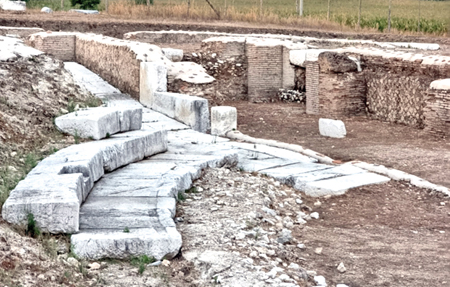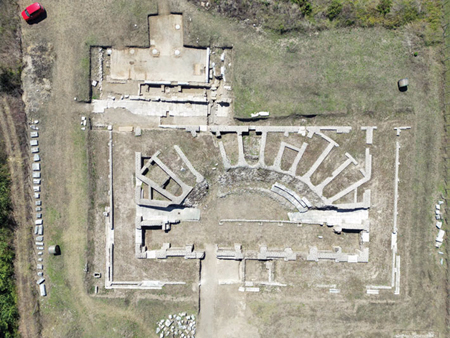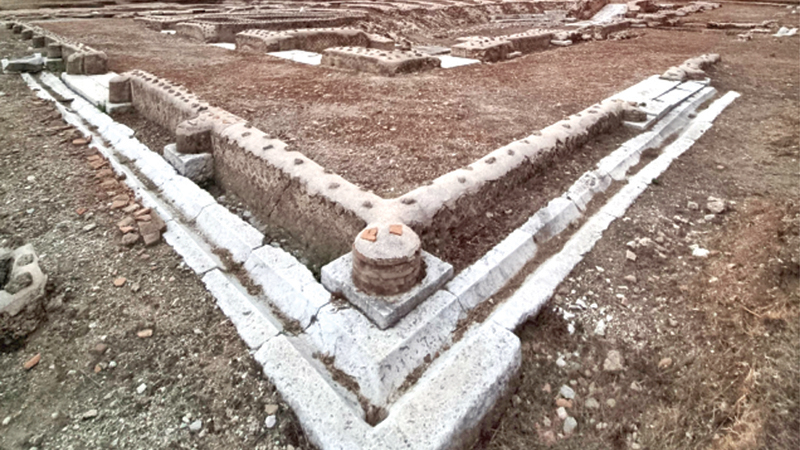 Interamna Lirenas, once overlooked as an insignificant Roman colony, is now emerging as an archaeological location offering fresh perspicuity into the daily life and political frameworks of provincial Roman towns. Located near the modern village of Pignataro Interamna in central Italy, this ancient settlement gives a valuable lens to study the spread of Roman culture and government outside the city of Rome.
Interamna Lirenas, once overlooked as an insignificant Roman colony, is now emerging as an archaeological location offering fresh perspicuity into the daily life and political frameworks of provincial Roman towns. Located near the modern village of Pignataro Interamna in central Italy, this ancient settlement gives a valuable lens to study the spread of Roman culture and government outside the city of Rome.
Founded in 312 BCE as a Latin colony, Interamna Lirenas was strategically placed along the Via Latina, a major Roman road connecting Rome to southern Italy. The town’s name—”Interamna” meaning “between rivers”—reflects its location near the Liri River. As part of Rome’s broader efforts to consolidate control over central Italy, the colony was designed to secure key trade routes vital to Roman expansion.
Once Roman dominance in the region was secured, Interamna Lirenas expanded in civic importance. By the early 1st century BCE, its inhabitants were granted full Roman citizenship, and the town achieved the status of a municipium. Around this time, Julius Caesar, who was allocating land to his veterans in the area, was named patronus municipii—a patron of the community. Profiting from its strategic position at the crossroads of critical transportation routes, Interamna developed into a hub for periodic markets (nundinae) that linked Rome with Apulia in the southeast. Economic prosperity came through trade, animal husbandry, and wool production, contributing to the wealth and growth of its population.
The town seems to have encountered a fairly peaceful existence until its eventual abandonment in the 6th century CE, likely initiated by the instability following the Lombard invasions of Italy.
Recent excavations

Ruins of the theatre
Recent archaeological surveys and excavations—especially those conducted by the University of Cambridge—have revealed a particularly well-preserved urban landscape. Findings include a gridded street plan typical of Roman city design, a forum, an amphitheatre, a basilica, market buildings, and domestic residences. Embellished mosaics, inscriptions, and a range of everyday artefacts suggest a thriving civic culture.
Despite its modest scale, Interamna Lirenas revealed a complex and prosperous political life. A significant discovery in 2017 was a well-preserved Roman sundial carrying the name Marcus Novius Tubula, a local magistrate. This rare object not only underlines the sophistication of civic timekeeping but also confirms the structured administrative procedures in place.
Inscriptions and public architecture further vouch for the town’s integration into the more expansive Roman imperial culture of Rome. Dedications to emperors and displays of public benefaction indicate an engaged citizenry that actively participated in the political and cultural life of the empire.
Through its material remains, Interamna Lirenas illustrates the depth and reach of Roman influence in the provinces, serving as a compelling case study of the resilience and adaptability of smaller Roman communities throughout the empire’s lifespan.
A Roman town rebranded
Long overlooked as a peripheral outpost, Interamna Lirenas is now identified as a prosperous illustration of how Roman institutions, architecture, and culture expanded into the less-celebrated intersections of the empire. Continuous excavations have revealed proof of intricate provincial governance, busy economic life, and affluence not too far removed from the grandness of Rome itself.
Contemporary archaeological work has altered our knowledge of the town’s legacy. According to a paper published in the journal, Roman Urbanism in Italy, Interamna Lirenas—located in central Italy—stayed prosperous well after the deterioration of the Western Roman Empire.
“We started with a site so unpromising that no one had ever tried to excavate it. That’s very rare in Italy,” said Alessandro Launaro, lead researcher of the Interamna Lirenas Project at the University of Cambridge’s Faculty of Classics.
These findings were unforeseen and groundbreaking, from a completely roofed theatre to marketplaces, extensive warehouses, and a river port, the evidence disassembled the long-held belief of Interamna Lirenas as a town in decline. Rather, it implied a resilient urban centre that prospered for well over 900 years—almost 300 years more than earlier thought.
“There was nothing on the surface, no visible evidence of constructions, just bits of broken pottery,” Launaro recalled. “But what we discovered wasn’t a backwater, far from it. We found a thriving town adapting to every challenge thrown at it for 900 years.”
Using cutting-edge approaches such as magnetic and ground-penetrating radar, archaeologists explored 60 acres of open farmland during targeted excavations. “We’re not saying that this town was special—it’s far more exciting than that,” Launaro said. “We think many other average Roman towns in Italy were just as resilient. It’s just that archaeologists have only recently begun to apply the right techniques and approaches to see this.”
Interamna Lirenas is materialising as a case study for reconsidering Roman urban history, questioning outdated premises and illustrating an enduring vibrancy of Rome’s so-called “ordinary” townlets.
Beyond the “backwater” label

An aerial view of basilica and theatre
Fundamental evidence reinforcing this reinterpretation lies in the investigation of everyday pottery. Instead of concentrating on imported pottery ware—which frequently signals privileged consumption—the research team analysed locally produced ceramics used for daily cooking and household activities. This grounded recourse allowed archaeologists to map population patterns and movement across the location, ensuring that Interamna Lirenas achieved its pinnacle during the late 2nd or early 1st century BCE and remained so until at least the late 3rd century CE.
“Based on the relative lack of imported pottery, archaeologists have presumed that Interamna Lirenas was a declining backwater town. We now know that wasn’t the case,” said Launaro. The town, which harboured about 2,000 citizens, had a booming local pottery industry that suggests active economic self-sufficiency. A recently uncovered inscription proposes that Julius Caesar may have visited the town in 46 BCE, attracted by its strategic placement along the key pathway linking Rome to southern Italy.
“This town continually played its cards right,” Launaro said. “It was always forging relations with communities between Rome and southern Italy while thriving as a trading hub.”
The River Liri, flowing near the territory, likely enhanced its position as a commercial centre. Archaeologists discovered exciting evidence of a riverside pier and large warehouses— measuring 131 by 39 feet—utilised to stow goods for provincial trade. Close by, they also found a temple and a bathing complex, one of three in the town, located conveniently close to the dock.
“River ports didn’t just need warehouses,” Launaro said. “People spent a lot of time working and resting in the vicinity, so they needed all kinds of amenities, just like the ones we found here.”
These conclusions collectively rebrand Interamna Lirenas as a busy and flexible Roman town, within larger networks of trade, politics, and culture, far withdrawn from the narrative of stagnation and decay.
Interamna Lirenas was more than just a provincial Roman town—it was a centre of civic pride and cultural investment. Among the most remarkable finds was a roofed theatre estimating approximately 147 by 85 feet, capable of accommodating around 1,500 spectators. Such an architecturally progressive and sizeable construction challenges earlier speculations that the town was in a state of decline. Rather, the theatre is a potent testament to the town’s dynamism, status, and local ambition.
Archaeological evidence demonstrates that the theatre was not only thoroughly operational but also experienced development during the town’s most active periods. Excavations revealed signs of structural transformations supported by wealthy patrons, suggesting a community immersed in the enhancement of its public spaces. Far from a site in decay, the theatre of Interamna Lirenas reflects a town devoted to preserving and advancing its public life and cultural essence.
Further findings have strengthened this picture of prosperity and resilience. Three bathhouse complexes exhibited unmistakable signs of continual use and maintenance well beyond the traditional timeline of the Roman Empire’s deterioration. Residential areas, notably, indicated no particular separation founded on social hierarchy, pointing towards a more integrated community structure.
Archaeologists focused their investigations on 19 courtyard-style buildings believed to have functioned as markets, warehouses, guild halls, or multi-story dwellings on the 60-acre site. One site seems to have functioned as a livestock market for sheep and cattle—a vital element of the area’s lucrative wool trade.
Calculated retreat
Interestingly, there is no archaeological evidence supporting destruction, such as a layer of ash or signs of devastation—suggesting a violent or abrupt end to the town. According to archaeologist Alessandro Launaro, Interamna Lirenas was probably gradually deserted as its inhabitants grew wary of the increasing instability and the danger of invading forces. Rather than encountering a catastrophic collapse, the town’s downfall occurs to have been a calculated retreat, advancing well beyond the Empire’s supposed golden age.
This re-evaluation opens a more general conversation about Roman towns once considered inconsequential or short-lived. Interamna Lirenas implies that many such communities may have endured far longer and more successfully than previously thought, surviving the shifts and uncertainties of a transforming empire.









